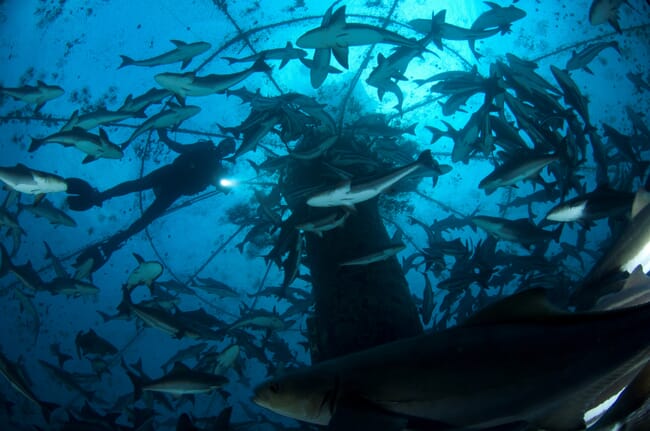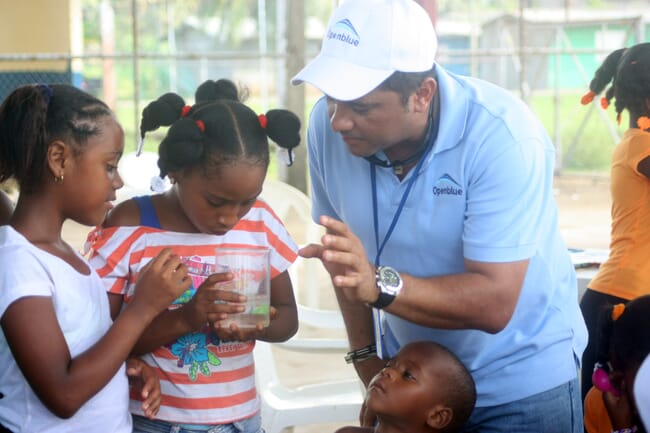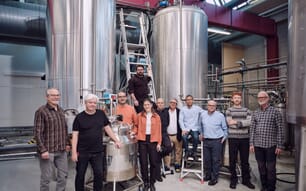Offshore cage culture, predominantly of salmonids, has exploded during the last two decades, while the production of species such as cobia in offshore locations is expanding rapidly due to the development of production technology. Although cage culture of cobia has developed off the coast of Mexico and Panama, the majority of cobia production (40,000 tonnes) still occurs in China. Eighty percent of all Taiwan’s marine cages are devoted to cobia culture, but Panamanian production now exceeds that of Taiwan, with only Vietnam and China producing more, according the latest estimates.

Open Blue has been growing large cobia off the Caribbean coast of Panama for about a decade. The integrated operation consists of a genetics programme, hatchery and 20, 6,400 m3 submerged cages, producing 1,500 tonnes a year. There are current plans to expand production through the adoption of 14,500 m3 cages.
The company has now expanded to provide cobia production from egg to plate, with a new processing facility recently opening , and it has become the main cobia producer in the Western Hemisphere.
Novel cage design
Open Blue uses a unique cage design developed by InnovaSea. Called the SeaStation, the submersible mariculture anchoring system with GPS is specifically designed to withstand and retain its shape and size under challenging deep water open ocean conditions such as strong currents, high wind speeds and high wave heights. Paradoxically, the pens need to be durable and yet lightweight so they can be installed, lifted and cleaned in these challenging conditions. Important design parameters especially incorporated for cobia include cost, worker safety and suitability for species requirements.
Perhaps the biggest challenge to cobia production is mortality associated with stress due to transfer of juveniles to grow-out cages. The fingerlings at Open Blue are transferred to the cages in the open ocean using a specialised pump and flexible hose system, so that fish are not handled and damage is minimised.
Sharks have been known to tear holes in the netting of cages and prey on cobia inside the net, which has resulted in serious losses of cobia in Puerto Rico and the Bahamas. However, cages at Open Blue are built from rigid Kikko netting with a tensile strength of 45kN/m that cannot be severed by sharks or obstructed by marine mammals. In addition, the cages can be periodically inverted so as to prevent build-up of growth of attached organisms.
Production cycle
Inside the hatchery, which employs tanks that exchange water and some that don’t, females release up to two million eggs freely every two weeks throughout the year dependent on stocking need. Fertilised eggs that are naturally buoyant are collected for placement in an incubation chamber. Eggs hatch 24 hours later and larvae begin feeding first on rotifers, then artemia, and are grown in a lab for up to seven days. After 30 days, fry change to eating dry feed and are grown to a size adequate for stocking which equates to a total of 70 days on land. Open Blue needs all the fingerlings they produce and do not sell any to the public.

Survival rates are typically 85 percent, while the FCR is 3:1. Harvest size is 3-5 kg which is achieved after 9-16 months, with females growing significantly faster than males. Fish are carefully harvested and immediately placed on ice and delivered fresh to the company’s processing facility.
Certifications and service to the community
Open Blue provides jobs for over 240 people and was the first cobia producer to achieve the Global Aquaculture Allaince's four-star Best Aquaculture Practice (BAP) certification, as well as the first to achieve certification by the Aquaculture Stewardship Council (ASC), in January 2018.
As Chris Ninnes, CEO of the ASC, said: “Open Blue’s certification shows leadership in responsible aquaculture and sets an example for cobia producers around the world.”
Each year the company awards 48 scholarships to allow children access to primary school education and makes regular contributions of cobia to the Panama Food Bank. There are also programmes to provide clean drinking water and the arrangement of regular beach clean-up activities in local areas.
Disease management
Ectoparasites present a problem to cobia cage culture, much like the cage culture of salmon in colder waters. The fluke, Neobenedenia, is the most predominant parasite found on cobia. Fish are sampled once per week for external parasites and hydrogen peroxide treatments are instigated if an average level of two parasites per fish is encountered. The company actually provides data on sampling parasites via their website.

To address this challenge with a more biological approach, two species of cleaner fish, the neon goby (Gobiosoma oceanops) and the bluehead wrasse (Thalassoma bifasciatum) have been shown to significantly decrease infestation rates by the ectoparasitic monogeneans (Neobenedenia melleni) from seawater-cultured Florida red tilapia. Although severe mortalities have been reported from Taiwan from a microscopic internal Myxosporean parasite, the Panamanian firm has yet to encounter this problem.
Environmental concerns
Benthic monitoring of production sites occurs twice per year, with a total of 29 samples taken between cages and outside the affected cage area. Bottom samples are taken and analysed for total carbon, redox potential and presence of macrofauna. Sediment samples analysed by the University of Miami show no difference in particulate nitrogen and chlorophyll directly under the cages or further afield. Monitoring of algal concentrations around the cage sites has not shown any significant differences since monitoring began in 2014.
There are adequate currents in the Caribbean around cages to prevent any problems with water quality parameters such as oxygen, carbon dioxide and waste nitrogen. A potential obstacle to land-based culture of cobia may be the formation of calcium deposits in the urethra of fish, causing mortality (kidney stones). This condition is thought to be associated with a moderately high carbon dioxide level of 10 mg/L only found in intensive recirculation systems (RASs).
Conclusion
The future of this company appears very bright. As the CEO of Publix supermarket chain, an important supporter of Open Blue, Guy Pizzuti, recently observed: “As we move forward with aquaculture as the future of seafood, promoting the sustainability of aquaculture is a critical component to gaining customer acceptance. Publix applauds and congratulates Open Blue for achieving ASC certification and leading the way in sustainable aquaculture.”




